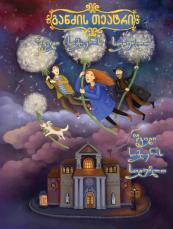THE THEATRE OF TREASURE
SADGOBELASHVILI NINO
In a riverside town there is a puppet theatre where happy and mysterious puppeteers work. Among them is the Gaburi family – Gagi, a blind puppeteer who makes eyes for the puppets, his wife Eva, who writes the music for the shows, and their 12-year-old daughter Taya, who has inherited a white birthmark on her shoulder the size of an ash-tree leaf, a sign that she can expect an eventful life… Taya’s friend is the artist Batu, who also works in the theatre. He comes from a town that no longer exists after a war, and the boy has found refuge in the Gaburi family, where he has undertaken to paint Taya’s room, which is how Batu and Taya became friends. The theatre is getting ready for a premier: a play about Amirani (the Georgian Prometheus) is to be staged, although for some reason nothing is going right and the frustrated director, Leo Lediani, consults the clairvoyant Tsaulina, who tells the director of imminent danger… This danger is hidden somewhere, in some part of the theatre, which will soon become clear. On her ninth birthday, Taya’s grandfather Leko reveals the secret of her family: their family has been cursed by a snake and that is why blind boys are constantly born in the family. The curse is connected with their family chalumeau which a distant ancestor Mindia took when he escaped from demons who had captured him. The chalumeau is now silent and, as a tradition says, when a red-haired girl with a birthmark is born and finds the tree from which the chalumeau has been carved, the musical instrument will regain its sound and the curse will be lifted. This is the tree to which the hero Amirani was chained… Taya gets to know the hunter Doro, who is to help her seek out Amirani. Doro has his own aims in this venture: once upon a time he lost his closest friend because of vengeance and this is whom he has to find. Batu will not let Taya go alone and leaves with her on this long journey. Their plan is this: on the last day of spring, Amirani has to sing his seventh song, and Taya must listen to this song to make the chalumeau sound out again, but to get to the seventh song they must find traces of the other six songs and recite them. Doro’s elderly friend, a famous hunter Tazi, helps him and this they find in succession the trace of the six songs which are linked to man’s sins. It is to free themselves from sin that people used to listen to these songs… The inhabitants of Demonia oppose Taya, Doro and Batu on this journey, because the demons wish to hear Amirani’s seventh song, only after doing so will they finally capture the human race and win Amirani over to their side, so that they can destroy the human beings’ god, the White Man. The travellers track down the six songs and are present at a final battle between the forces of the human race and the demons, which takes place on the fields of joy. Taya sees Doro finding his friend, and her chalumeau recovers its old sound. As for the seventh song, everyone hears it, because Taya and Batu sing it in the theatre at the premiere of the new show. The show is called Amirani.
‘Nino Sadghobelashvili’s book is very varied in genre, it is a fantasy which has been put together in a masterly way, a fairy story, an adventure. If The Theatre of Treasure is translated into a foreign language, international readers will learn a great deal about Georgian culture, traditions, customs.’
‘Nino Sadghobelashvili’s book is very varied in genre, it is a fantasy which has been put together in a masterly way, a fairy story, an adventure. If The Theatre of Treasure is translated into a foreign language, international readers will learn a great deal about Georgian culture, traditions, customs.’
M. Dumbadze, writer
Extract will be available soon
In case of using the information, please, indicate the source.
